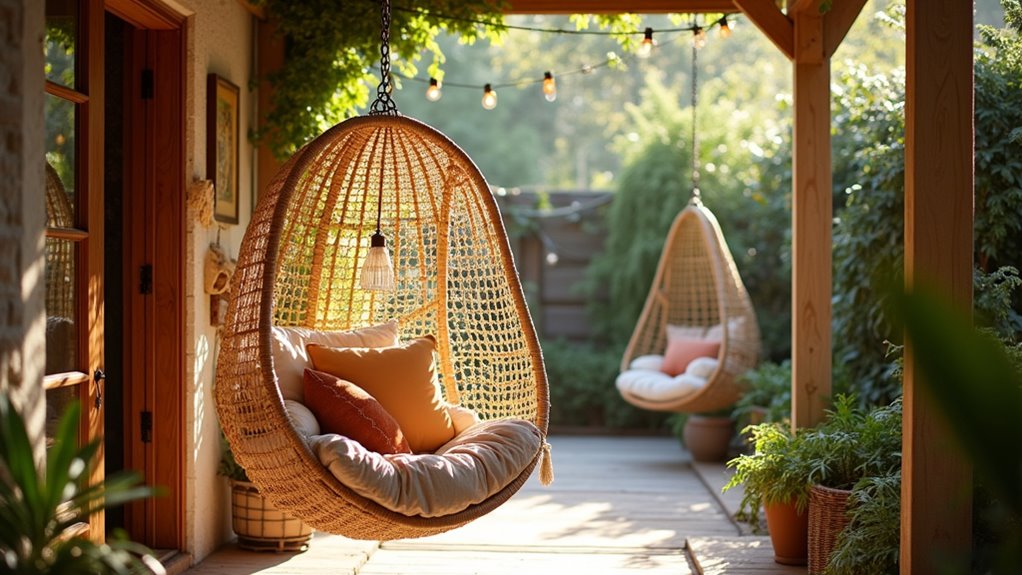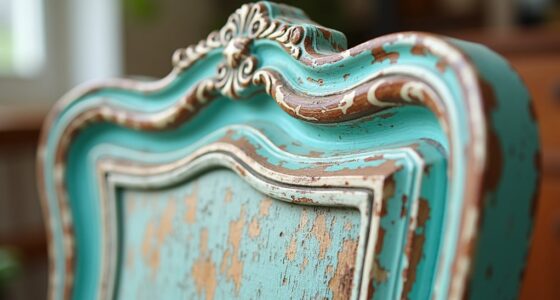To add a swinging boho vibe indoors or outdoors, choose a sturdy support like ceiling joists, beams, or trees rated for at least 300 lbs. Gather tools like a drill, stud finder, and hardware rated for heavy loads. Install secure hooks or eye bolts, ensuring they’re level and properly anchored to support weight safely. Adjust the height for comfort and space. For more tips on creating a cozy, stylish setup and maintaining safety, keep exploring.
Key Takeaways
- Select a sturdy support point like ceiling joists or outdoor trees rated for at least 300 lbs.
- Use appropriate hardware such as screw eyes, galvanized chains, and carabiners rated for maximum weight.
- Ensure at least 3 ft overhead clearance and 14 inches on each side for safe swinging space.
- Hang the chair 18-24 inches above the ground with level support for balance and comfort.
- Enhance the boho vibe with hanging plants, woven textiles, fairy lights, and layered rugs around your installation area.
Choosing the Perfect Location for Your Hanging Chair

To guarantee your hanging chair is both safe and comfortable, start by selecting a location with ample overhead space—at least 3 feet of clearance behind and 14 inches on each side. Check that the ceiling support, beam, or support structure can handle the weight capacity, typically around 330 pounds. Measure the space carefully, ensuring the installation area avoids obstacles like walls or furniture that could interfere with swinging or lounging. Consider the height from the attachment point to the floor, aiming for about 18-24 inches of clearance for comfort. Place your chair in a spot that complements your decor, whether in an outdoor patio, sunroom, or indoor corner. Proper space measurement and obstacle avoidance ensure safe, enjoyable use of your hanging chair. Additionally, assess the installation process to ensure your chosen spot can accommodate the necessary hardware and secure mounting for long-term safety. To enhance stability, verify the support structure can sustain the dynamic forces exerted during use. Selecting a location with appropriate overhead support is essential for safety and durability, and assessing the load capacity of the support helps prevent accidents or damage. For added peace of mind, consider using water-resistant or weatherproof materials if placing the chair outdoors to prolong its lifespan.
Gathering the Necessary Tools and Materials
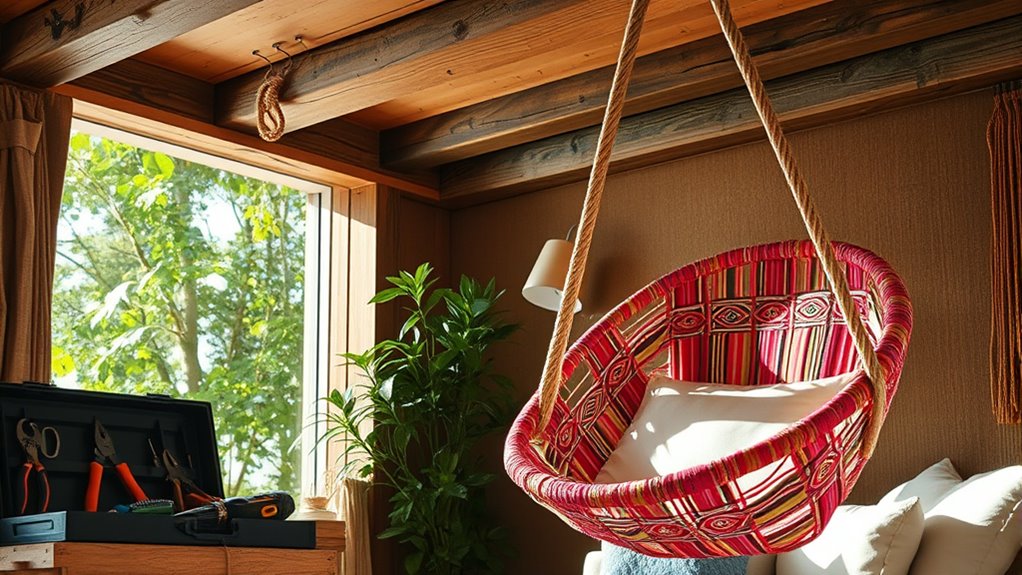
Before you begin installing your hanging chair, gather all the necessary tools and materials to assure a smooth process. You’ll need an installation tools kit, including a drill, stud finder, measuring tape, pencil, and appropriate hanging hardware like screw eyes or hooks rated for at least 300 pounds. Collect hardware components such as galvanized chains, heavy-duty ropes, and carabiners, along with your hanging chair or hammock with a secure attachment ring. Use the stud finder to locate a ceiling joist or support beams capable of bearing the weight capacity. Mark the points for drilling with a pencil, and if attaching to concrete or masonry, prepare expansion bolts. Confirm that all hardware and tools meet safety standards for a secure, stable installation. Incorporating space and organization strategies can also help keep your installation area tidy and accessible. Additionally, considering Alaskan shipbuilding techniques can provide insight into durable fastening methods suitable for various environments. Ensuring proper weight capacity is essential for safety and durability during use. Properly assessing the hybrid bike features and support structures can inspire confidence in your hanging chair installation, especially if you’re adapting techniques for different environments.
Finding Support Structures for Indoor and Outdoor Setups
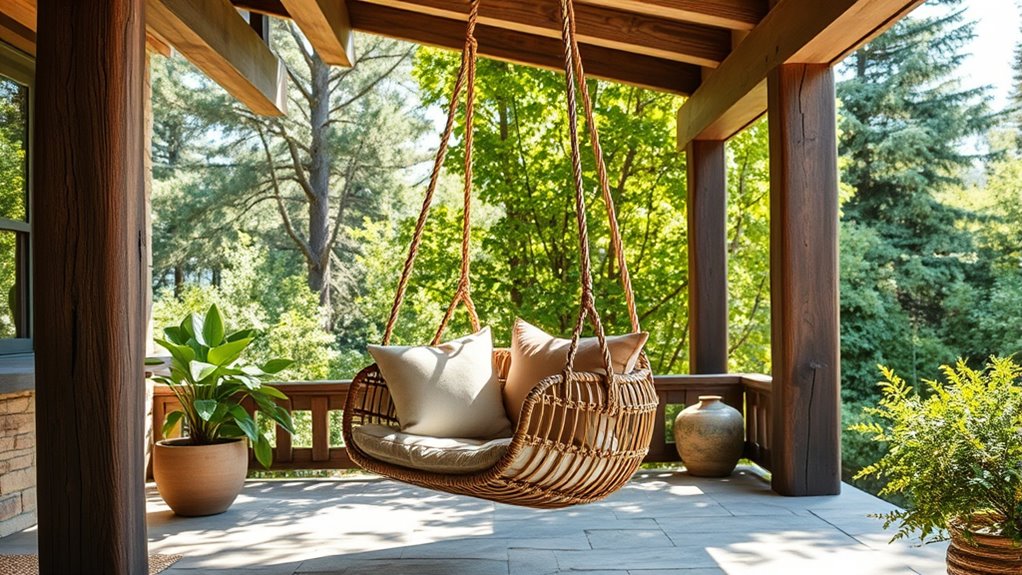
Finding a sturdy support structure is vital for a safe and comfortable hanging chair setup, whether indoors or outdoors. For indoor installation, ceiling joists, ceiling beams, or dedicated mounting brackets must support at least 300-600 pounds. Use a stud finder to locate these supports and guarantee proper placement. Outdoor supports like trees, porch beams, or external supports rated for the weight of your swing chair work well outside. Hardware safety is essential; select screw eyes, chains, and carabiners compatible with your support structure’s material and weight capacity. For rental spaces or unsupported areas, portable stands offer flexible, secure options without permanent modifications. Here’s a quick guide:
| Support Type | Suitable Hardware | Notes |
|---|---|---|
| Ceiling Joists | Heavy-duty eye bolts, chains | Indoor, ceiling installation |
| Outdoor Supports | Tree branches, porch beams | Outdoor, natural supports |
| Portable Stands | Stable frame, reinforced base | No permanent setup |
Installing Hardware Safely and Securely
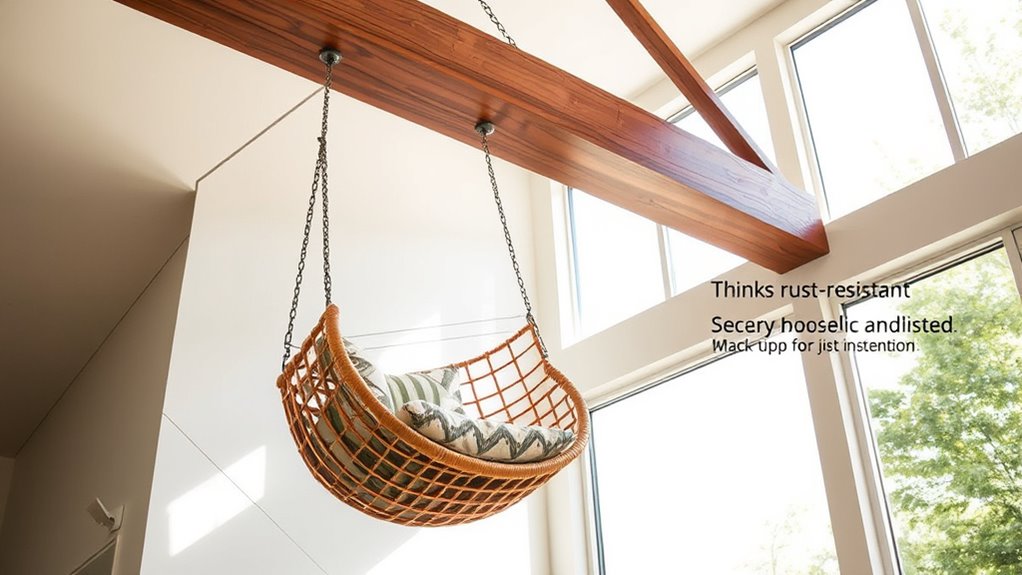
Proper hardware installation is key to guaranteeing your hanging chair remains secure and safe. First, use a stud finder to locate sturdy support beams or ceiling joists with a minimum weight capacity of 600 pounds. Select heavy-duty hardware like screw eyes, ceiling hooks, or wall brackets rated for at least 300 pounds. Drill pilot holes slightly smaller than your hardware to prevent splitting and improve stability. Always attach hardware into solid structural elements, avoiding drywall or plaster alone, to support the load safely. Before hanging your chair, double-check the hardware’s weight capacity and test stability gently. This process ensures your setup is secure and safe, giving you peace of mind while enjoying your swinging boho vibe indoors or outdoors. Additionally, choosing hardware that is designed for specific weight can help prevent accidents and ensure longevity. Incorporating AI safety detection tools can further enhance security by monitoring hardware stability over time. Being aware of key traits of successful QA engineers can also help in selecting the right hardware and installation tools, ensuring a durable and safe setup.
Adjusting Height and Ensuring Proper Balance
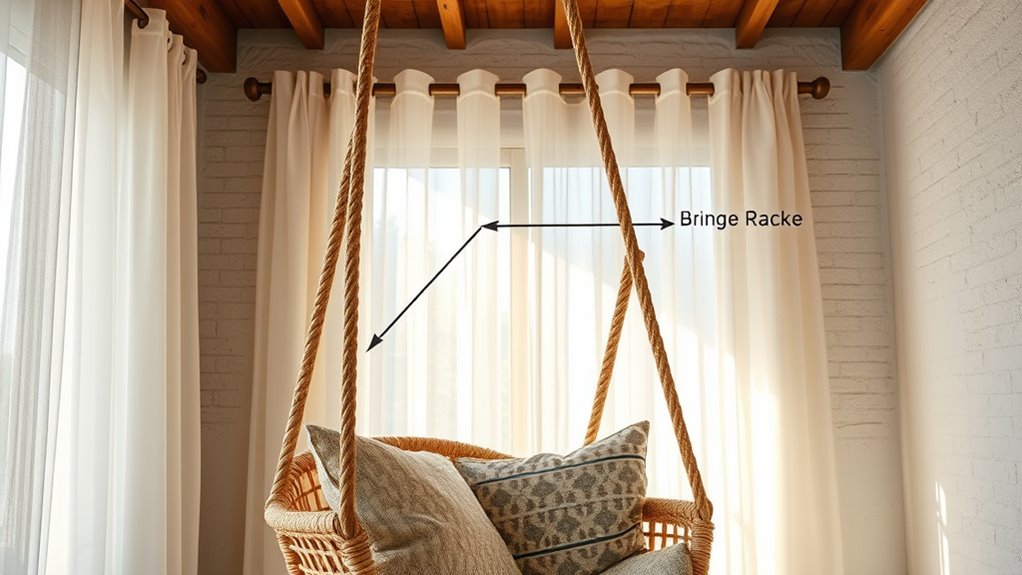
To guarantee your hanging chair is both comfortable and safe, you need to set the right height and check its balance. Adjust the chain or rope so the seat hangs about 18-24 inches above the ground, and use a level to make sure everything is even. Test the balance by gently sitting in the chair and making small tweaks until it feels secure and comfortable. Ensuring proper placement and air circulation can also help maintain stability and safety. Additionally, inspecting the structural integrity of the mounting point ensures it can support the weight safely. Considering remote work comfort habits, such as maintaining proper posture, can also enhance your experience and prevent discomfort during extended use. Incorporating self-awareness techniques can help you recognize and adjust for any signs of instability or discomfort during use.
Optimal Hanging Height
Adjusting the hanging height of your boho hanging chair is essential for both comfort and safety. The ideal hanging height is typically 18-24 inches above the ground, providing a comfortable swing and easy access. To achieve this, you can tweak the rope length or adjust the chain links until the seat is at the right level. Make sure your ceiling hook and suspension are sturdy enough to support the weight securely. Proper adjustment ensures the chair hangs evenly and maintains balance, preventing tilting or excessive swinging. Regularly check and fine-tune the height for different users or improved comfort. Remember these installation tips:
- Ensure a secure ceiling hook and sturdy suspension
- Adjust rope length for the perfect height
- Check balance and symmetry
- Keep it a comfortable swing within reach
- Consider weight capacity when adjusting the height to ensure safety and durability
Additionally, understanding the best installation practices can help prevent accidents and prolong the longevity of your hanging chair. Incorporating knowledge about ethical hacking principles can also remind you to regularly inspect and secure your setup against potential hazards, ensuring safety remains a priority.
Achieving Even Balance
Ensuring your hanging chair is balanced involves verifying that all support points are at the same height before installation. Check that each hanging point is level and capable of supporting equal weight to prevent tilting or uneven swinging. Use a leveling tool to measure and adjust the ropes or chains to ensure the seat hangs evenly. When attaching the hardware, confirm that it’s secure and capable of supporting the weight distribution evenly across all support points. Test the balance by gently rocking the chair and making small height adjustments as needed. Regularly inspect and tighten the hardware to maintain proper balance, especially after outdoor exposure or frequent use. Proper adjustments ensure a stable, level seat, enhancing safety and comfort during every swing. Additionally, verifying the compatibility of your hardware with different headphone jacks can help ensure secure and safe connections for electronic accessories used during installation or adjustment. Regularly checking the support points for wear and tear can also prevent unexpected accidents and prolong the lifespan of your hanging chair, especially when considering weight capacity and overall safety standards. Incorporating support system maintenance into your routine can further enhance safety and longevity.
Adjusting for Comfort
Achieving ideal comfort with your hanging chair starts with setting the right height and making sure it’s properly balanced. To do this, adjust the height by adding or removing chain links or rope sections until the swing hangs about 18-24 inches above the ground. Ensure the chair is level and balanced by evenly distributing weight on both sides of the attachment point, preventing tilting. Test the swing’s position by gently sitting and making minor height adjustments for maximum comfort and safety. Use leveling tools or a smartphone app to verify proper positioning and balance. Regularly inspect hardware, tightening hooks and chains as needed to maintain hardware tightening and proper weight distribution, preventing uneven swinging and ensuring a safe, comfortable experience. Remember to consider outdoor weather conditions that could affect hardware stability and safety over time. Additionally, understanding industry trends can help you select the best hardware options for longevity and safety. It’s also beneficial to familiarize yourself with installation guidelines to ensure your setup adheres to safety standards and manufacturer recommendations.
Tips for Hanging Indoors: Space and Safety Considerations

Before hanging your chair indoors, make sure your ceiling or support structure can safely hold at least 600 pounds. Leave at least 3 feet of clearance behind and 14 inches on each side for safe swinging space. Use a stud finder to locate ceiling joists and secure hardware directly into them for maximum support.
Supportive Ceiling Structures
To safely hang a hanging chair indoors, you need a ceiling that can support the weight without risk of damage or failure. Ensuring ceiling support involves checking the ceiling joists’ location and strength, typically using a stud finder to locate sturdy studs. Confirm that your ceiling material—be it wood, concrete, or beam—can handle the load. You might need ceiling reinforcement or a support board spanning multiple joists to distribute weight evenly and prevent sagging. Proper hardware installation is essential; use strong support hardware rated for the chair’s weight capacity. Always prioritize ceiling integrity to avoid accidents.
- Locate studs with a stud finder for reliable support
- Use support hardware designed for ceiling support and load distribution
- Reinforce ceilings if necessary to improve ceiling support
- Follow weight capacity guidelines to ensure safety
Adequate Clearance Space
Ensuring adequate clearance space is essential for both safety and comfort when hanging a chair indoors. You should leave a minimum of 3 feet of hanging space behind the chair to prevent hitting walls or obstacles during swinging. On each side, maintain at least 14 inches of obstacle distance to allow comfortable movement. Measure the height from the ceiling or support point to the floor to determine an appropriate swing height, avoiding excessive swinging. Confirm that the ceiling support or support structure can safely bear the weight of the chair and occupant, with a safety margin of at least 25%. Use a level to verify that the installation is even, ensuring the swinging area remains within the designated space and the hanging position is safe.
Secure Hardware Installation
Using the right hardware is essential for a safe and secure hanging setup. First, locate a strong support structure using a stud finder to identify ceiling joists that can handle at least 300 pounds. Choose a ceiling hook or screw eye rated for your chair’s weight capacity, and verify it’s suitable for indoor or outdoor use. Drill pilot holes slightly smaller than the hardware to prevent cracking and make installation easier. Use galvanized chains and locking carabiners that are weather-resistant and rated for maximum weight. Regularly inspect all hardware for signs of rust damage, wear, or damage to maintain safety. Keep an eye on attachment points and replace any compromised components immediately to avoid accidents. Proper hardware ensures your hanging chair stays secure and safe for everyone.
Best Practices for Outdoor Installation in Trees and Beams
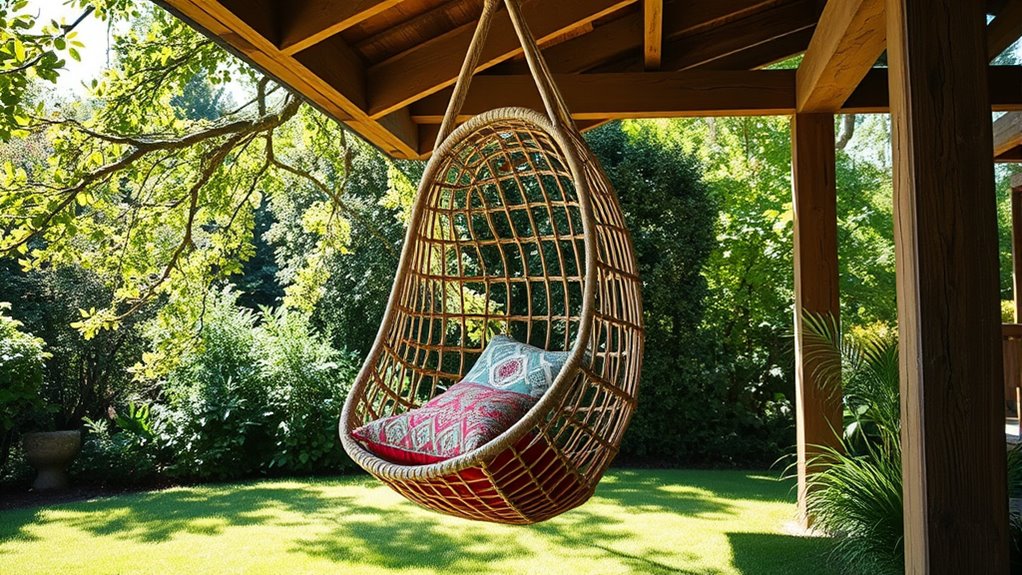
Selecting the right support points is essential for a safe and durable outdoor hanging chair setup. Whether using a tree support or beam support, choose a support point with at least an 8-inch diameter to handle the weight of your hammock or hanging chair securely. Use heavy-duty hardware like galvanized eye bolts or tree straps rated for at least 600 pounds to guarantee hardware safety and prevent slipping. Attach the hammock with corrosion-resistant carabiners or quick links designed for outdoor installation, increasing longevity. Position your support at a height that provides at least 24 inches of clearance height below the seat for safe swinging and comfort. Regularly inspect support points, hardware, and surrounding branches or beams for signs of rust, wear, or damage to maintain safety over time.
Decorating Your Hanging Chair Area for a Boho Aesthetic

To achieve a charming boho vibe around your hanging chair, focus on layering textures and natural materials. Use plush cushions, throws, and macrame hangers to add comfort and visual interest. Incorporate natural materials like rattan, jute, and woven textiles to enhance the boho decor, whether indoors or outdoors. Hang fairy lights, lanterns, or LED string lights nearby to create a cozy ambiance that invites relaxation. Surround your space with plant greenery or hanging plants to evoke a lush, earthy atmosphere. To define the area, add decorative rugs or floor poufs, which contribute layered textures typical of boho style. This approach transforms your hanging chair into a stylish, inviting nook filled with natural charm and laid-back elegance.
- Use woven textiles and rattan accents to add warmth
- Incorporate fairy lights for a cozy glow
- Add indoor plants or hanging greenery for a lush vibe
- Use rugs and poufs to define and layer your space
Maintaining and Checking Hardware for Longevity
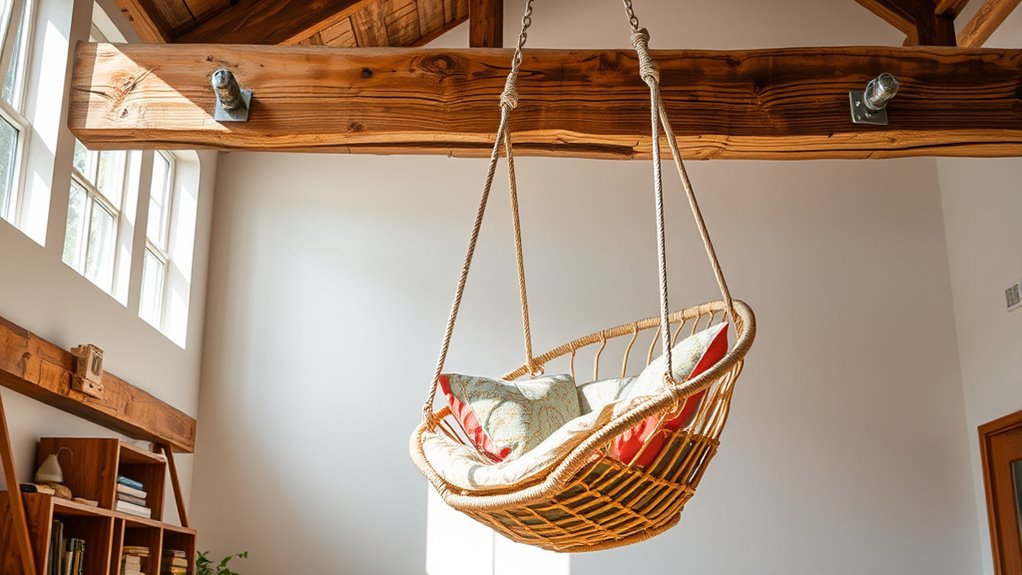
Regularly inspecting your hanging chair hardware is essential for ensuring safety and longevity. You should inspect all hardware components, including hooks, chains, and carabiners, for signs of rust, corrosion, or wear. Tighten any loose screws or fittings to maintain stability and prevent accidents. If you notice damage or weakened hardware, replace it immediately to avoid potential falls. Using a load tester or weight scale periodically helps verify that your hardware can still support the maximum weight capacity. Keep the hardware clean with appropriate solutions to prevent dirt and moisture buildup, which can accelerate deterioration. Consistent maintenance of your hardware components guarantees your hanging chair remains secure and functional, allowing you to enjoy your boho-inspired space for years to come.
Frequently Asked Questions
Can You Hang a Swing Chair Indoors?
Yes, you can hang a swing chair indoors if your ceiling or support can bear the weight safely. Make sure to use sturdy hardware like ceiling hooks, eye bolts, and strong chains or ropes. Use a stud finder to locate ceiling joists or support beams, and hang the chair about 18-24 inches above the floor for safe swinging. Always check the weight capacity before installation to guarantee safety.
Can My Ceiling Support a Hanging Chair?
You wonder if your ceiling can support a hanging chair, and that’s a smart question. It turns out, your ceiling’s strength depends on the joists or beams, which should be solid wood capable of holding at least 300 pounds. Use a stud finder to locate these joists, and guarantee you install a heavy-duty hook or eye bolt directly into them. Always check the chair’s weight capacity and hardware ratings for safety.
What Is a Swing Chair Outdoor Called?
You might wonder what an outdoor swing chair is called, and it’s often referred to as a porch swing or patio swing. If it has a hammock-like design, it’s called a hammock chair or hammock swing. When specifically designed for outdoor use, it’s usually called a garden swing or outdoor hanging chair. These names highlight its relaxed, swinging style and weather-resistant features perfect for your porch, garden, or patio.
How to Hang a Boho Hammock?
To hang a boho hammock, start by finding sturdy support like a ceiling joist or beam with a stud finder. Install a heavy-duty screw eye or ceiling hook capable of supporting at least 300 pounds. Attach the hammock’s metal rings or loops with locking carabiners or strong chains. Measure 18-24 inches above the ground for comfortable height, then regularly check hardware for stability and wear, especially outdoors.
Conclusion
With a little care and creativity, your hanging chair can become a cozy haven, much like a secret garden or a peaceful retreat. As you step back and sway gently, you’ll feel the same calm as a lullaby sung softly in a moonlit forest. Keep safety in mind, and your boho oasis will bring joy and relaxation for years to come—turning any space into your personal sanctuary, just like a hidden treasure waiting to be discovered.
